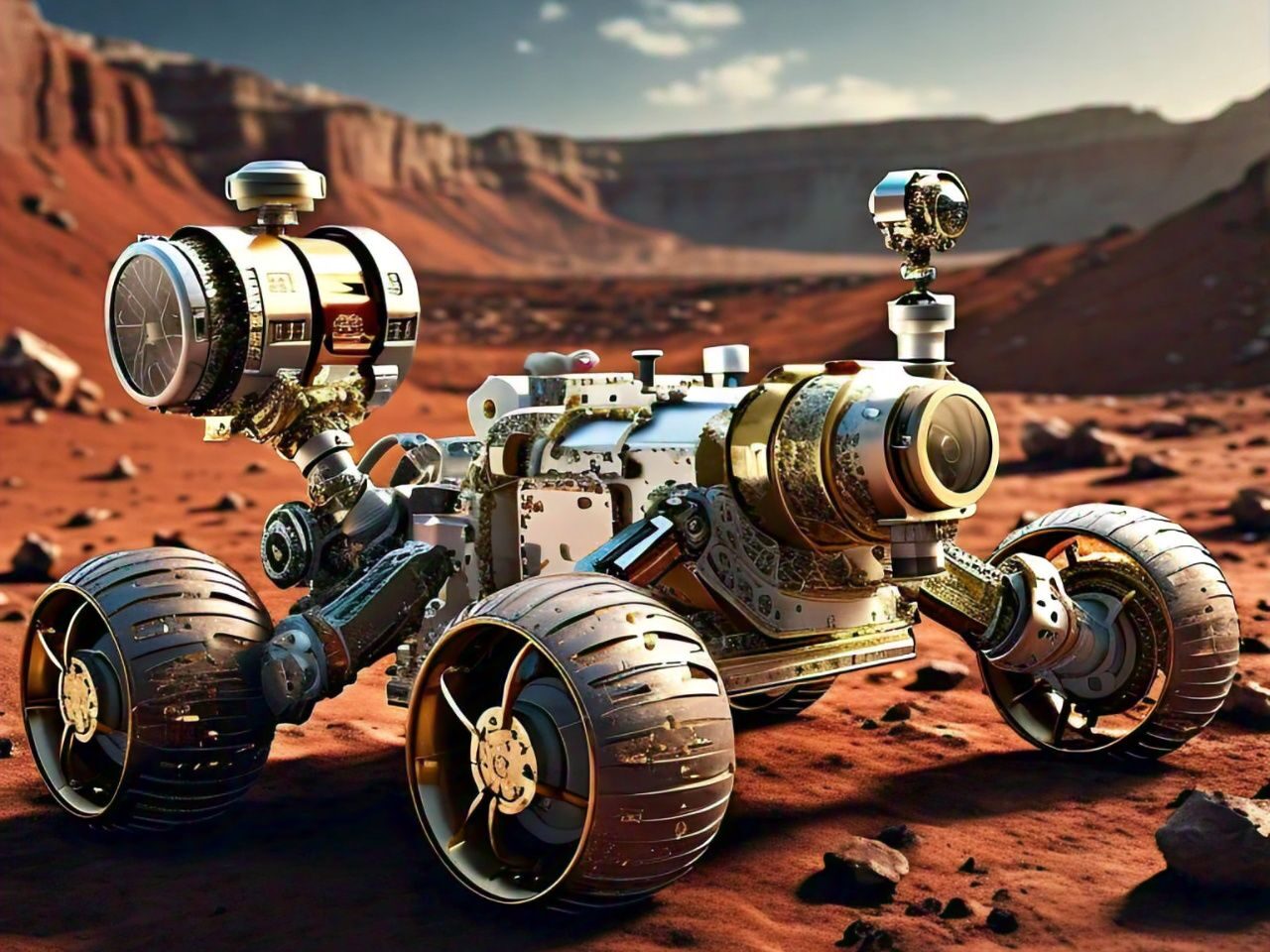Discover how NASA’s Perseverance Rover is revolutionizing our understanding of Mars with its latest finding of organic molecules in a Martian rock sample, possibly indicating ancient microbial life.

Let’s explore the details of this exciting discovery, the technology enabling these find and what it all means for humanity’s adventure to answer the question: Is there life on Mars?
Mars: A Planet of Possibilities
Mars, often called Earth’s “sister planet,” is considered a prime candidate for exploring life beyond Earth. Billions of years ago, Mars had liquid water, a thicker atmosphere, and possibly even an Earth-like climate. These conditions could have supported microbial life, making it a key focus of astrobiology research.
NASA’s Perseverance Rover landed in Jezero Crater in February 2021 a site once home to an ancient lake and river delta. This location was chosen because of its potential to preserve chemical fingerprints, or signs of past life, in its sedimentary rock layers.
Percy’s Breakthrough: Organic Molecules Found in Martian Rock
In July 2023, Perseverance drilled into a reddish rock at a site named Cheyava Falls. This rock turned out to be the first Mars sample from Jezero Crater to contain organic molecules carbon-based compounds that are fundamental to life on Earth.
According to Katie Stack Morgan, the deputy project scientist for Perseverance at NASA’s Jet Propulsion Laboratory, this discovery is the “most compelling sample we’ve found yet.” While these organic molecules are not definitive evidence of life, their presence raises tantalizing possibilities.
Adding intrigue to the discovery, the rock featured unusual white spots with black rims, resembling “tricolored leopard spots.” Chemical analysis revealed that these spots contained iron phosphate, a compound that, on Earth, has been linked to ancient microbial activity.
What Do These Discoveries Mean?
Although the discovery of organic molecules is exciting, it doesn’t necessarily mean that life once existed on Mars. As Stack Morgan explains, such chemical features can form through non-biological processes as well. However, their resemblance to similar formations on Earth where microbes played a role—opens the door to a possible biological origin.

To complicate matters, the same rock also contains calcium sulphate veins filled with tiny crystals of olivine, a mineral formed by volcanic magma. The coexistence of these volcanic features and potential biosignatures in a single rock is a puzzle for scientists, pointing to multiple possible origins and environmental conditions.
Understanding how this rock formed, and whether its conditions could have supported life, will require further analysis. Percy’s instruments, including PIXL and SHERLOC, will continue to provide critical data to unravel these mysteries.
for more image visited NASA official website Click
Building on Past Discoveries
This isn’t the first time NASA has found organic molecules on Mars. In 2014, the Curiosity rover detected organics in rocks at Gale Crater, another ancient lakebed. However, scientists struggled to identify such molecules in Jezero Crater—until now.
The presence of organic compounds in multiple locations strengthens the case for Mars as a planet that may have once harbored life. These findings underscore the importance of returning rock samples to Earth for detailed study.
Technological Triumphs: Making Oxygen and More
In addition to searching for life, Perseverance is paving the way for future human exploration of Mars. Using a device called MOXIE, the rover has successfully converted carbon dioxide from the Martian atmosphere into oxygen. This technology could one day support human missions to Mars by providing breathable air and rocket fuel.
Why the Search for Life on Mars Matters
Finding signs of life on Mars would be one of the most profound discoveries in human history. It would redefine our understanding of biology and the origins of life in the universe. Even if the search ultimately proves that Mars is lifeless, the knowledge gained about planetary processes and Mars’ history will guide future missions to other worlds.
The discovery of organic molecules at Cheyava Falls highlights the incredible progress we have made, but it also emphasizes how much remains to be explored. As Perseverance continues its mission, we can look forward to even more ground-breaking insights.
Mars in Culture: Blending Science and Imagination
Beyond its scientific significance, Mars has long been a cultural icon. David Bowie’s song Life on Mars? and countless science fiction works have portrayed the Red Planet as a place of mystery and possibility. With Perseverance’s discoveries, science and imagination are coming together to write the real story of Mars.
Table of Contents fast track
Conclusion: A Giant Leap for Space Exploration
NASA’s Perseverance Rover is bringing us closer to understanding Mars’ potential for life. Whether it’s the discovery of organic matter, mysterious rock formations, or the ability to make oxygen, each finding is a stepping stone toward answering the ultimate question: Are we alone in the universe?
Stay tuned as the mission unfolds, and don’t forget to share your thoughts in the comments below! Could Percy’s discoveries be the first chapter in humanity’s greatest story?
FAQs on NASA’s Perseverance Rover and the Discovery of Organic Molecules on Mars
1. What is the Perseverance Rover, and what is its main mission?
Answer: NASA’s Perseverance Rover, often nicknamed “Percy,” is a robotic explorer designed to study the geology and search for signs of past microbial life on Mars. It landed in Jezero Crater in February 2021 and is equipped with advanced instruments to collect rock and soil samples, analyze organic molecules, and test technology for future human missions.
2. Why was Jezero Crater chosen as the landing site for Perseverance?
Answer: Jezero Crater was selected because it was once home to a lake and river delta, making it an ideal location for preserving ancient signs of life. Scientists believe the sedimentary rock layers here could contain chemical fingerprints of past microbial activity, providing vital clues about Mars’ habitability billions of years ago.
3. What are organic molecules, and why are they important?
Answer: Organic molecules are carbon-based compounds that are fundamental to life on Earth. Their discovery on Mars is significant because they could suggest the presence of ancient microbial life. However, they can also form through non-biological processes, so further analysis is necessary to determine their origin.
4. What did Perseverance discover in the rock sample from Cheyava Falls?
Answer: In July 2023, Perseverance drilled into a rock at Cheyava Falls and found organic molecules within. This sample also featured unique white spots with black rims, resembling “tricolored leopard spots,” and contained iron phosphate, a compound linked to ancient microbial activity on Earth.
5. Do the organic molecules found by Perseverance prove that life once existed on Mars?
Answer: No, the presence of organic molecules alone does not prove that life existed on Mars. These compounds could have formed through non-biological processes. However, their similarity to formations associated with life on Earth raises intriguing possibilities that require further exploration.
6. How do scientists analyze the Martian rocks?
Answer: Perseverance uses several high-tech instruments, such as PIXL (Planetary Instrument for X-ray Lithochemistry) and SHERLOC (Scanning Habitable Environments with Raman & Luminescence for Organics and Chemicals), to conduct detailed chemical analyses of Martian rocks and identify organic molecules.
7. How does the discovery at Cheyava Falls compare to previous findings by NASA?
Answer: This discovery builds on previous detections of organic molecules made by NASA’s Curiosity rover at Gale Crater in 2014. The identification of organics in Jezero Crater is especially compelling because it strengthens the case for Mars as a planet that may have once been habitable.
8. What is MOXIE, and how is it helping future human missions to Mars?
Answer: MOXIE (Mars Oxygen In-Situ Resource Utilization Experiment) is a device on Perseverance that converts carbon dioxide from Mars’ atmosphere into oxygen. This technology is a major step toward supporting human exploration, as it could provide breathable air and fuel for rockets in the future.
9. Why is finding life on Mars so significant?
Answer: Discovering signs of life on Mars would be one of the most transformative scientific discoveries, changing our understanding of biology and the origins of life in the universe. Even if Mars is found to be lifeless, the insights gained will inform our understanding of planetary processes and help guide future explorations.
10. What challenges do scientists face in interpreting these discoveries?
Answer: One challenge is that organic molecules and mineral formations, such as calcium sulfate veins and olivine crystals, can form through both biological and non-biological processes. Understanding the environmental conditions that created these features requires complex analysis and comparison to similar formations on Earth.
black holes explore recent discoveries and the mysteries that captivate scientists explore


3 thoughts on “The Search for Life on Mars: Updates from NASA’s Perseverance Rover”